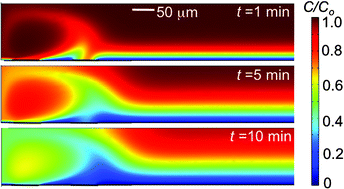AC-driven electrothermal flow is used to enhance the temporal performance of heterogeneous immuno-sensors in microfluidic systems by nearly an order of magnitude. AC electrokinetic forces are used to generate electrothermal flow, which in turn produces a circular stirring fluid motion that enhances the transport of diffusion-limited proteins. This provides more binding opportunities between suspended antigens and wall-immobilized antibodies. We investigate experimentally the effectiveness of electrothermal stirring, using a biotin–streptavidin heterogeneous assay, in which biotin is immobilized, and fluorescently-labeled streptavidin is suspended in a high conductivity buffer (σ = 1.0 S m−1). Microfabricated electrodes were integrated within a microwell and driven at a frequency of f= 200 kHz and 10 Vrms. Fluorescent intensity measurements show that for a five minute assay, electrothermal stirring increases the binding rate by a factor of almost nine. Similar binding improvement was measured for longer assays, up to fifteen minutes. The electrothermal enhancement of this assay was modeled numerically and agrees with experimental binding rates. The measured fluid velocity of 22 ± 2 µm s−1 was significantly lower than that predicted by the numerical model, 1.1 mm s−1, but nevertheless shows the same fourth power dependence on applied potential. The results demonstrate the ability for electrothermal stirring to reliably improve the response time and sensitivity within a given time limit for microfluidic diffusion-limited sensors.

You have access to this article
 Please wait while we load your content...
Something went wrong. Try again?
Please wait while we load your content...
Something went wrong. Try again?


 Please wait while we load your content...
Please wait while we load your content...